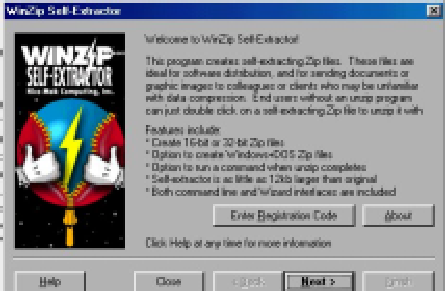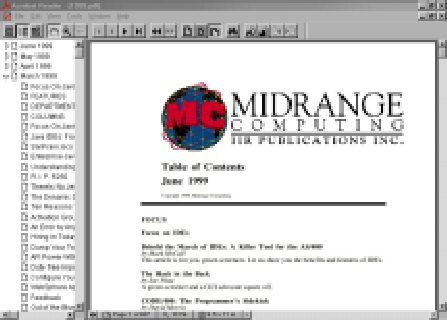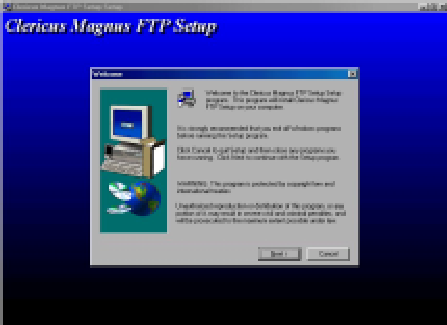I was talking with a friend of mine recently, a fellow AS/400 programmer, and something came to light that I’d never given much thought to before. AS/400 programmers who only program on green-screens or PCs using 5250 emulation may not know about many of the common PC software utilities, programs, and other knowledge many of us take for granted. Not convinced? Let me give you a little background on my friend. She has been working as a consultant, programming in RPG and Synon on the AS/400 for about five years. Although she feels she’s an accomplished AS/400 programmer, she knows that by having only AS/400 green-screen programming skills, she is limiting her opportunities and professional future. With that in mind, she has been slowly moving away from the AS/400 and into the PC arena by taking on projects programming in Microsoft Access, a tool she has never used before. In the near future, she plans to move into true client/server programming by learning and working on projects written in Visual Basic. To say this has been a major learning curve for her would be an understatement. Up to this time, her world has consisted of the AS/400 and a dumb terminal. If she used a PC at all, it was only as a sophisticated dumb terminal to get an emulation session to the AS/400.
Things other computer geeks like you (yes, you!) and me take for granted are completely foreign to people like my friend. For example, when told to make a self- extracting .zip file containing a group of MS Access objects that needed to be delivered to a client, my friend was completely baffled. A self-extracting .zip file? What the heck is that? She had never heard of WinZip (Figure 1) or PKZIP. In fact, she didn’t even know that you could zip (compress) files or why you would even need to in the first place.
This conversation with her got me to thinking about all the other AS/400 green- screen programmers out there who may also have some gaps in their knowledge when it comes to what many of us would consider “popular” PC software packages and utilities. With that in mind, I decided that an article in the world’s premier AS/400 industry magazine, Midrange Computing, that focuses on some of the more common, free, or nearly free PC software tools and utilities available would come in rather handy. Let this article serve as a primer for anyone in your shop who may be a whiz on the AS/400 but a little light on knowledge of PCs.
Zip It Up, Mister!
Most diskettes will hold just under 1.44 MB of data. That sounds like a lot until you realize that an average computer image, such as a .jpg file, which is a type of image file, can take up as much as 1000 KB, or just under 1 MB, of space. Many are even larger. If you need to copy a lot of images to diskette (to load onto another computer, for example), you may find that you are running out of diskette space very quickly. Add to those images an MS Word document or two, and you will quickly come to appreciate the need for compressing data. This is what zipping, or compressing, a file or series of files means. The data is compressed from its original size to something considerably smaller, thereby letting you store more information in less space. PC utilities such as WinZip and PKZIP allow you to easily create .zip, or compressed, files that can then be copied to diskette or even sent as an email attachment. PKZIP has been around for many years and was widely used as a DOS program before an MS Windows version of the tool came out. WinZip has been around for quite a while, too, and has become the de facto standard compression utility for Windows users.
Both utilities work pretty much the same way. Each allows you to add multiple objects (files, programs, entire directories, etc.) to a .zip file. Each also allows you to create a self-extracting .zip file.
A self-extracting .zip file is just what it sounds like. When you double-click on this self-extracting executable, it starts a temporary version of the software that created the self- extracting program (WinZip or PKZIP) and extracts (unzips/decompresses) all the files in that .zip file to the default location (if any) specified when the files were zipped. This process can make distributing software to users a piece of cake. All you need to do is tell them to double-click on a file contained on a diskette or sent as an email attachment, and the software will be installed in the correct location. PKZIP and WinZip do not have to exist on the target computer for self-extraction to work. PKZIP has a self-extractor built into it, but you must download and install both WinZip and the WinZip Self-Extractor program to use the WinZip self-extraction feature. Each .zip utility is available as a trial version, but the manufacturers would love you to purchase a license for its use. However, neither product has a time limit on how long you can use it without purchasing a license.
A Picture Is Worth a Thousand Words
If you are a frequent reader of this magazine, you’ve probably noticed that we include a lot of screen shots as article figures. We do this because it’s much easier to show the reader how a utility will look than it is to describe it. Pictures are dynamic and exciting and can make otherwise boring text sing! Have you ever wondered how you can capture your own AS/400 or PC screens? Why you would even want to? How about if you create user documentation for software that you write in-house? An image of the actual screen will go over much better than a “drawing” of that screen made up of the plus (+) or equal (=) symbols you may have used in the past.
You can perform a screen capture in several ways. The simplest is to press the PC’s Print Screen key while the screen you want to capture is displayed. The image of your computer screen is placed on the computer’s clipboard, and from there, you can paste it into a word processing document. This technique works fine, but it does have some drawbacks, the biggest one being that you cannot control how much of the screen gets captured. If you are displaying multiple windows when you perform the screen capture, you will get all those windows in your document when you paste it, not just the window you wanted to capture. The other major drawback is that you cannot save this screen capture as an image file such as a .jpg or .gif file. This means you cannot manipulate it apart from the word processing document.
Using image processing software such as Jasc Software’s Paint Shop Pro is a better way to capture screens. With such a package, you can capture any portion of a desired screen. You, not the computer, define the amount of data captured. What’s more, you can then save this screen capture as a regular computer image in a variety of standard
formats: .bmp (bitmap), .jpg (JPEG), .gif (CompuServe format), .tif (tagged image format), etc. If you feel that the screen capture is too dark, just edit it using the image- processing software. Perhaps a bit lighter here, and maybe a shade or two darker there. Insert this new image into your documentation, and suddenly, you have a user’s manual that will make your users sit up and take notice! You can download a 90-day trial version of Paint Shop Pro at www.jasc.com. If you decide to buy it, the price is pretty reasonable (somewhere below $75). Another popular image-processing software package is Adobe Photoshop (www.adobe.com). You can also find a number of shareware image processing programs.
It’s All in the Packaging
One of the most common ways to disseminate information on the Web is through the use of
.pdf files. These files are a special type of file format that have the ability to store data in text and image forms in one convenient location. An Adobe PDF creator generates these
.pdf files, which people commonly use to share information in a booklike format. .pdf files can contain text, graphics, a table of contents, and even indexes to data stored in the .pdf document. Everyone from IBM to Midrange Computing (Figure 2) to the local plumbing supply house that has its own Web site uses .pdf files to distribute instructions, user manuals, and product catalogs. In the case of Midrange Computing, all the back issues of Midrange Computing, AS/400 Network Expert, and AS/400 NetJava Expert are stored as
.pdf documents on our ResourceCD. The proliferation of .pdf files will continue to grow as companies and individuals upgrade their MS Office suite or Corel suite to the 2000 versions available right now. Both software suites have an integrated PDF creator built in. That means that when you create your snazzy user documentation in Word or WordPerfect, you can now export it as a .pdf document and distribute it via email or other electronic means to your users.
All that’s required to read a .pdf document is the free version of the Adobe Acrobat PDF Reader available from the Adobe Web site. After you download this free tool, simply double-click on the self-extracting .zip file to install it on your PC. It will even load itself as a plug-in to your Internet Explorer or Netscape Navigator Web browser so that you can automatically open Web-based .pdf documents by clicking on them at the Web site.
Making Software Installation and Distribution a Breeze
If you’re an AS/400 green-screen programmer, you may have never had to install software on a PC. If that’s the case, then you’ve probably never seen InstallShield at work. Used by most PC software vendors, InstallShield has become the de facto industry standard for distributing and installing PC software. Using InstallShield, a vendor can package all the programs, files, installation instructions, and documentation needed to install a software package into one simple module that the user can easily install. Generally, a software installation using InstallShield consists of placing a CD-ROM in the PC’s CD-ROM drive and clicking on the Setup icon when prompted. If your PC has the Autorun feature turned on (which means that a CD-ROM containing a file named AUTORUN.INF on it automatically begins executing the instructions defined in this text file), you may not even need to click on the SETUP icon, because, as you might have guessed, it automatically begins running. When the setup process starts, you’ll see a screen similar to the one in Figure 3, customized with the vendor’s product information. The figure in this example shows the InstallShield product in action, installing a vendor’s product. The actual InstallShield screen you will see will depend on how the vendor customized its installation program. You may be prompted to accept the license agreement; to select the directory where you want the software installed; and as to whether you want a compact, typical, or custom installation. That’s pretty much it. InstallShield then installs the software and configures it while you sit back and watch it run. Even IBM uses InstallShield to install Client Access/400 on your PC. InstallShield is free for the user who actually installs the
software. However, the software vendor must purchase a license to use it to package its software for distribution.
It’s Not Who You Know, It’s Where You Go!
The last bit of PC software knowledge you need isn’t really a software package. Instead, it’s a Web site you can visit to find and download a ton of free or nearly free shareware software. Shareware, for those of you who may be wondering, is software that folks just like you and me write and share with the rest of the world either for free or for a nominal fee. It’s usually $50 or less. To get to one of the best sources of PC shareware on the Internet, point your browser to www.shareware.com. This is the Holy Grail of shareware Web sites. From there, you can download all the software discussed in this article as well as search for and download a wider variety of software and games than you could ever imagine existed!
For example, looking for a way to create a comma-delimited list of all the files on your personal computer? It’s there! Or maybe you want the latest version of your favorite Web browser. It’s there, too! What if you’re the kind of person who can work only 3 hours at a time before you need a game of computer solitaire? Aren’t you tired of that same old solitaire game that came with your computer? Well, look no further! At Shareware.com, you can find literally hundreds of different versions of this computer classic. There are also a number of AS/400 shareware Web sites you can visit to download software and fixes either for free or for a nominal price (Figure 4).
A Gathering of Geeks
Knowing about the various PC software and utilities available may not necessarily make you a more productive AS/400 programmer or administrator, but it can make you a more polished AS/400 professional. Besides, why should the PC geeks have all the fun, talking about zipping this, capturing that, or downloading those? Now, you can join the party, too!
Figure 1: Create self-extracting .zip files with WinZip.
 |
 |
 |
Figure 4: Here's a list of useful Internet URLs you can visit for free software.












 Business users want new applications now. Market and regulatory pressures require faster application updates and delivery into production. Your IBM i developers may be approaching retirement, and you see no sure way to fill their positions with experienced developers. In addition, you may be caught between maintaining your existing applications and the uncertainty of moving to something new.
Business users want new applications now. Market and regulatory pressures require faster application updates and delivery into production. Your IBM i developers may be approaching retirement, and you see no sure way to fill their positions with experienced developers. In addition, you may be caught between maintaining your existing applications and the uncertainty of moving to something new. IT managers hoping to find new IBM i talent are discovering that the pool of experienced RPG programmers and operators or administrators with intimate knowledge of the operating system and the applications that run on it is small. This begs the question: How will you manage the platform that supports such a big part of your business? This guide offers strategies and software suggestions to help you plan IT staffing and resources and smooth the transition after your AS/400 talent retires. Read on to learn:
IT managers hoping to find new IBM i talent are discovering that the pool of experienced RPG programmers and operators or administrators with intimate knowledge of the operating system and the applications that run on it is small. This begs the question: How will you manage the platform that supports such a big part of your business? This guide offers strategies and software suggestions to help you plan IT staffing and resources and smooth the transition after your AS/400 talent retires. Read on to learn:
LATEST COMMENTS
MC Press Online